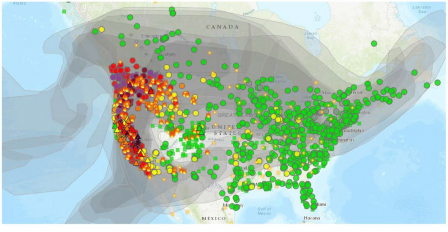Research Supports Air Sensor Data Pilot Conducted in 2020 Wildfire Season
Published January 28, 2021

As wildfires impacted western states last summer and fall, many people turned to the AirNow Fire and Smoke Map, managed by EPA, to understand if smoke was affecting their air quality. To provide air quality information in areas without permanent monitors, EPA and the U.S. Forest Service (USFS) conducted the AirNow Sensor Data Pilot from August to December of 2020.
The pilot provided measurement data from a commercial network of PurpleAir sensors of the air pollutant, fine particulate matter (PM2.5), a component of smoke that is harmful to health. The sensors supplemented existing stationary and temporary monitoring provided by state, local or tribal air quality agencies.
Krishna Viswanathan in EPA’s Region 10 office located in the Pacific Northwest explains that the sensors have improved the ability of people to protect their health from smoke in communities impacted by wildfires in California and other nearby states.
“Decisions such as when to walk the dog or whether to hold an outdoor sports practice are made easier for the millions of people that now have access to this information in their community,” says Viswanathan.
The use of the sensors on the Fire and Smoke Map has been made possible by EPA science. Through extensive field testing, EPA scientists discovered that PurpleAir sensors consistently overestimate PM2.5 concentrations. To make the data more comparable to the regulatory and temporary monitors, EPA researchers developed a correction equation. They also developed a series of quality control checks and validated the correction for wildfire smoke.
“During the wildfire events, we received a tremendous amount of positive feedback from our state, local, and tribal partners as well as the public about the availability of corrected and quality-assured sensor data,” says Elizabeth Adams, in EPA’s Region 9 office, headquartered in San Francisco where wildfires have contributed to smoke conditions.
A public webinar will be conducted Jan. 28 from 1-3 p.m. ET to offer information on the AirNow Sensor Data Pilot and a technical overview of the development and performance validation of a U.S.-wide correction equation for the PurpleAir sensor data.
The sensor data remains on the AirNow.gov web page for use by the public. EPA and the USFS plan to continually improve the Fire and Smoke Map, including the sensor data display, with the goal of having an upgraded version available in time for the 2021 fire season.
Learn More:
